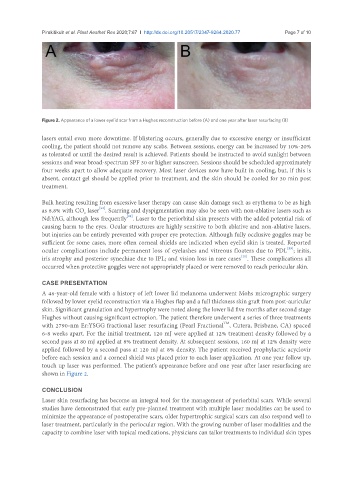Page 793 - Read Online
P. 793
Pirakitikulr et al. Plast Aesthet Res 2020;7:67 I http://dx.doi.org/10.20517/2347-9264.2020.77 Page 7 of 10
Figure 2. Appearance of a lower eyelid scar from a Hughes reconstruction before (A) and one year after laser resurfacing (B)
lasers entail even more downtime. If blistering occurs, generally due to excessive energy or insufficient
cooling, the patient should not remove any scabs. Between sessions, energy can be increased by 10%-20%
as tolerated or until the desired result is achieved. Patients should be instructed to avoid sunlight between
sessions and wear broad-spectrum SPF 30 or higher sunscreen. Sessions should be scheduled approximately
four weeks apart to allow adequate recovery. Most laser devices now have built in cooling, but, if this is
absent, contact gel should be applied prior to treatment, and the skin should be cooled for 30 min post
treatment.
Bulk heating resulting from excessive laser therapy can cause skin damage such as erythema to be as high
[52]
as 8.8% with CO laser . Scarring and dyspigmentation may also be seen with non-ablative lasers such as
2
[29]
Nd:YAG, although less frequently . Laser to the periorbital skin presents with the added potential risk of
causing harm to the eyes. Ocular structures are highly sensitive to both ablative and non-ablative lasers,
but injuries can be entirely prevented with proper eye protection. Although fully occlusive goggles may be
sufficient for some cases, more often corneal shields are indicated when eyelid skin is treated. Reported
[29]
ocular complications include permanent loss of eyelashes and vitreous floaters due to PDL ; iritis,
[11]
iris atrophy and posterior synechiae due to IPL; and vision loss in rare cases . These complications all
occurred when protective goggles were not appropriately placed or were removed to reach periocular skin.
CASE PRESENTATION
A 48-year-old female with a history of left lower lid melanoma underwent Mohs micrographic surgery
followed by lower eyelid reconstruction via a Hughes flap and a full thickness skin graft from post-auricular
skin. Significant granulation and hypertrophy were noted along the lower lid five months after second stage
Hughes without causing significant ectropion. The patient therefore underwent a series of three treatments
TM
with 2790-nm Er:YSGG fractional laser resurfacing (Pearl Fractional , Cutera, Brisbane, CA) spaced
6-8 weeks apart. For the initial treatment, 120 mJ were applied at 12% treatment density followed by a
second pass at 80 mJ applied at 8% treatment density. At subsequent sessions, 160 mJ at 12% density were
applied followed by a second pass at 120 mJ at 8% density. The patient received prophylactic acyclovir
before each session and a corneal shield was placed prior to each laser application. At one year follow up,
touch up laser was performed. The patient’s appearance before and one year after laser resurfacing are
shown in Figure 2.
CONCLUSION
Laser skin resurfacing has become an integral tool for the management of periorbital scars. While several
studies have demonstrated that early pre-planned treatment with multiple laser modalities can be used to
minimize the appearance of postoperative scars, older hypertrophic surgical scars can also respond well to
laser treatment, particularly in the periocular region. With the growing number of laser modalities and the
capacity to combine laser with topical medications, physicians can tailor treatments to individual skin types

